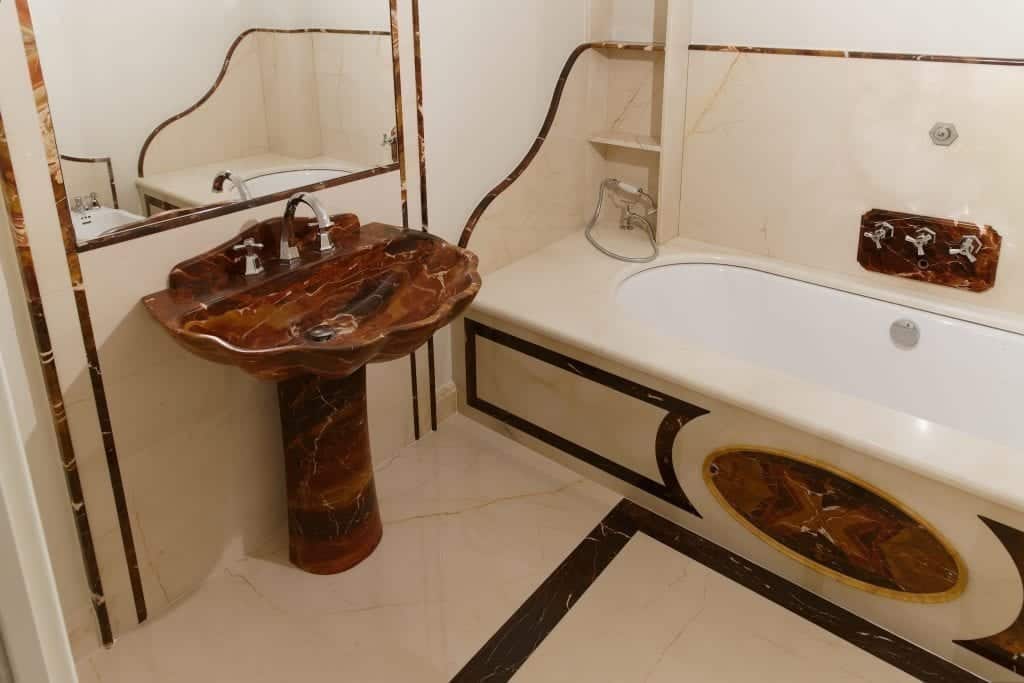Jasper - Ancient Libeccio of Sicily
The undisputed king of the Baroque, this marble was particularly beloved
by sculptor Gian Lorenzo Bernini, who used it profusely
in many of his works, among them, admirable is the drape carved into the tomb
of Pope Alexander VII at St. Peter's in the Vatican.
King of Baroque
The soft jasper of Sicily is mined in the mountains of Custonaci and has an unpredictable coloration ranging from dark red to yellow ochre, with rare white intrusions. In the past it was also known by the name of Custonaci libeccio
From the same quarry, pontifical breccia and Sicilian Rose are extracted.
Unique in the world
Its uniqueness together with the difficulties involved in its extraction make the soft jasper of Sicily a particularly valuable material: once used especially in the most important churches and noble palaces today it is used in open-spot slabs for important floors or wall coverings in bathrooms and living rooms.

Ancient libeck or Jasper is a polygenic limestone with clasts up to decimetric in size, originating from variously colored layers of a single formation and sometimes intermixed with clusters of bioclasts. Such fragments, with mainly angular contours, are immersed in a cement consisting of calcareous muds deposited in paleokarst pockets whose color tones range from burgundy red to brown, from dark yellow to beige to pistachio green. Belonging to geological formations of the Upper Triassic (ca. 200 million years ago), it was formed in a marine environment.
Historically called Libyan of Trapani or Soft Jasper of Sicily, it is quarried at c.ca 550m above sea level in the Trapani area of Custonaci, Sicily's largest mining basin and the second largest in Europe.
The first traces of its use occur in the late 1500s by refining the use of this stone with Carrara marble in the decoration of monuments and churches began to spread its use first in Sicily and then in the rest of Italy was also appreciated outside Sicily and from the nearby port of Trapani was exported during the 17th and VXIII centuries, finding use in relevant architecture in many Italian cities. Among the most prestigious works is the tomb of Alexander VII in St. Peter's Basilica in the Vatican, carved by Gian Lorenzo Bernini between 1672-78; in the funerary monument centered on the statue of the praying pope, jasper, overcoming difficulties related to the uneven nature of the material, was used to shape the heavy drapery that wraps the sculptures-personifications of Charity, Truth, Justice, and Prudence-and hangs over the door below, incorporating a gilded skeleton with an hourglass. In the Royal Palace of Caserta, built by Luigi Vanvitelli from 1751 for Charles III of Bourbon, along with other Sicilian marbles (Castronovo yellow and Billiemi gray) libeccio was used to embellish the interiors, as in the balustrade of the imposing staircase leading to the royal apartments or again in the hexagonal tile floor of the Hall of Mars.
Jasper realizations can also be found in Piedmont: here Filippo Juvarra, perhaps mindful of the qualities of the marbles of his homeland, made use of it in various architectures, as shown in the interior of the church of the Confraternity of the Most Holy Trinity (1717-1734), where blocks of this marble imported from Sicily were used to make cornices and mirrors.
The architectures mentioned certainly do not exhaust the case studies, and the selection made for mere illustrative purposes shows how the ancient libeccio from Custonaci, in all possible uses (small tiles for inlays and thin slabs for veneers, as well as large slabs combined "in open spots" to create extraordinary polychrome designs for wall coverings and altar mirrors, or even elements in the round, such as balusters and medium-sized columns), because of its material characteristics, which make it a natural "miscellaneous" marble, in Vasari's meaning of the term, it can be considered the most "baroque" of Sicilian marbles, perfectly in line with the creative tension underlying many of the works of this artistic season.
St. Peter's in the Vatican
Tomb of Pope Alexander VII
last work of Gian Lorenzo Bernini



